GUO Chuanbin Team
The long-term goal of our team is to achieve precision diagnosis and treatment of HNSCC as well as functional rehabilitation of craniomaxillofacial diseases.
Our team focuses on precision diagnosis of Head and Neck Squamous Cell Carcinoma (HNSCC) lymph node metastasis as well as precision treatment of skull base tumors by utilizing the robot system developed by our team. Our team is exploring artificial joints musculoskeletal dynamics for functional rehabilitation. We also develop biodegradable magnesium alloy materials for craniomaxillofacial defect repair.

Our first major research focuses on precision diagnosis and treatment of HNSCC. Our research focuses on precision diagnosis of occult cervical lymph node metastasis using large-sample cohorts and multi-omics analysis to identify key metastatic factors, aiming to translate findings into clinical practice for head and neck tumor management. We've developed two automated robots for mandibular reconstruction and skull base tumor surgery, enhancing precision in complex anatomies. Additionally, we explore tumor microenvironment regulation through probiotic delivery systems, investigating metabolic-immune mechanisms to advance targeted cancer therapies.
Our second major research focuses on functional artificial joints and musculoskeletal dynamics studies. Our team pioneered the "Envelope Surface of Condyle Movement (ESCM)" concept. We quantified ESCM in healthy adults, developed a facial shape-based predictive model, and used multibody dynamics to show that ESCM-guided TMJ socket prostheses improve condylar mobility and reduce muscle activation during mouth opening.
Our third major research focused on the applications of biodegradable magnesium-based alloys for maxillofacial defect reconstruction. Our group has carried out a series of original studies and has successively overcome a series of problems, including the ultra-purification of biodegradable magnesium metals, the laser non-corrosive rapid processing technology of magnesium films, the precise regulation of the degradation of biodegradable magnesium bone regeneration membranes, and the adaptability of oral soft and hard tissue regeneration.
DIRECTOR
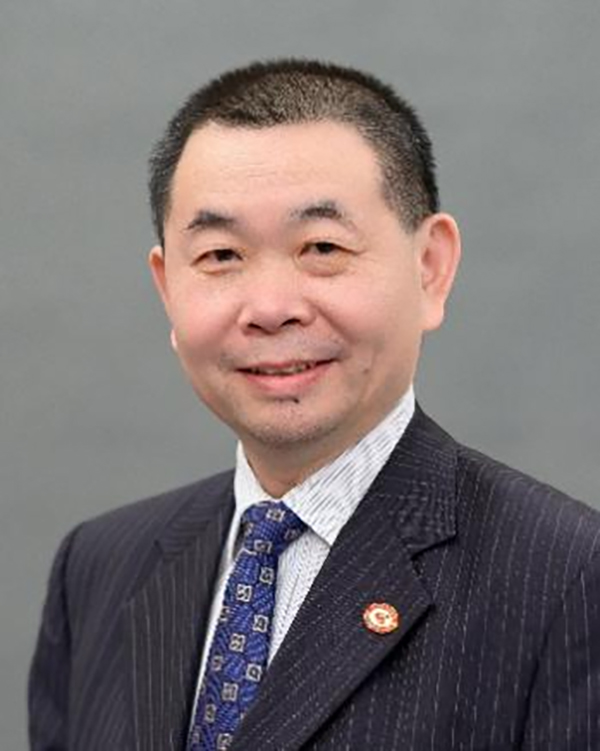
Chuanbin Guo
Professor, Chief Physician
Principal Investigator
guodazuo@sina.vip.com
Mr. Guo Chuanbin is Professor of oral and maxillofacial surgery at Peking University School and Hospital of Stomatology. He is also President of Chinese Stomatological Association, Vice President of Chinese Medical Doctor Association.
Professor Guo is engaged in clinical and laboratory study on oral and maxillofacial surgery and is highly experienced in the diagnosis and treatment of oral tumors and tumors involving the skull base. He has a great interest in innovative research. He and his team focused on advancing precision diagnostics for lymph node metastasis in HNSCC through multimodal biomarker analysis; implementing robot-assisted surgical systems for targeted skull base tumor resection and mandibular anatomical reconstruction; investigating innovating functional rehabilitation solutions via biomechanical studies of artificial joints and developing bioresorbable magnesium alloys for craniomaxillofacial bone regeneration. These interdisciplinary efforts aim to bridge translational research with clinical applications in head and neck oncology. He has published 367 papers, presided over more than 10 national and provincial-level research projects, obtained 14 authorized invention patents, achieved 4 patents commercialization. In addition, he has also received 9 various provincial and ministerial-level or above scientific and technological awards, including the Second Prize of the National Science and Technology Progress Award.
RESEARCH AREAS
Research on precision diagnosis and treatment of HNSCC
Our primary research initiative centers on advancing precision medicine paradigms for HNSCC, with a dual focus on diagnostic innovation and therapeutic optimization. First, in the aspect of precision diagnosis, we target occult cervical lymph node metastasis—a critical prognostic factor in HNSCC progression. Leveraging large-scale, prospectively maintained clinical cohorts, we integrate multi-omics profiling (transcriptomic, proteomic, metabolomic, and radiomic data layers) to decode molecular drivers of metastatic dissemination. Advanced machine learning algorithms are employed to identify biomarker signatures predictive of micro-metastasis, enabling early-stage detection and risk stratification.
Second, our team pioneer’s robot-assisted precision surgery to address anatomically complex head and neck malignancies.
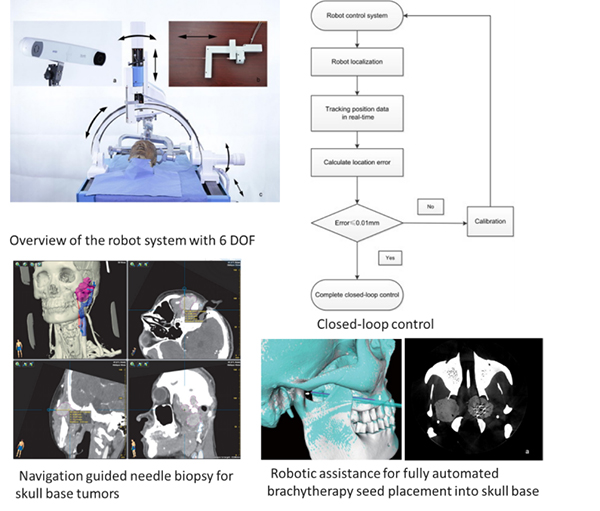
Third, we are redefining tumor microenvironment modulation through bioengineered probiotic delivery systems. By programming probiotic vectors to selectively colonize hypoxic tumor niches, we achieve spatiotemporal release of immunomodulators and metabolic disruptors. Parallel work investigates the crosstalk between immune-metabolic reprogramming.
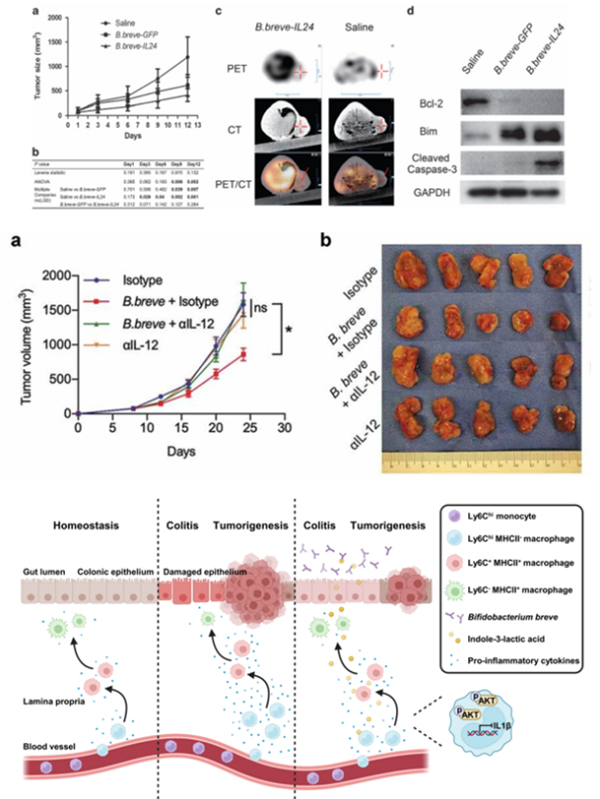
Application of probiotics B.breve in targeting tumor therapy and immune-metabolic reprogramming
Research on Functional Artificial Joints and Musculoskeletal Dynamics
Our team has innovatively introduced the concept of the "Envelope Surface of Condyle Movement (ESCM)" and empirically validated that the condyle exhibits a smoother motion compared to the bony articular fossa during movement. We performed quantitative assessments of ESCM in healthy adults and developed a mathematical model grounded in facial shape parameters, which successfully predicts the morphology of ESCM. Subsequent multibody dynamics analysis suggests that designing artificial temporomandibular joint socket prostheses based on ESCM can significantly enhance the range of condylar motion and decrease muscle activation during mouth opening. This study offers a novel theoretical framework and methodology for the design of artificial temporomandibular joint socket prostheses. We established the first digital database for mandibular movements in China. Multi body dynamics modeling and analysis of the oral and maxillofacial system were conducted on normal individuals and patients undergoing jaw reconstruction. By combining joint motion data with robot systems and pneumatic artificial muscles, a temporomandibular joint motion simulator can be constructed and used as a carrier for in vitro wear tests. Our team was the first to introduce the concept of elasticity in temporomandibular joint prostheses. We developed a bionic elastic layer using a 3D-printed porous polyethylene mixture, which was then integrated with titanium metal alloys to create prostheses exhibiting physiological elasticity.
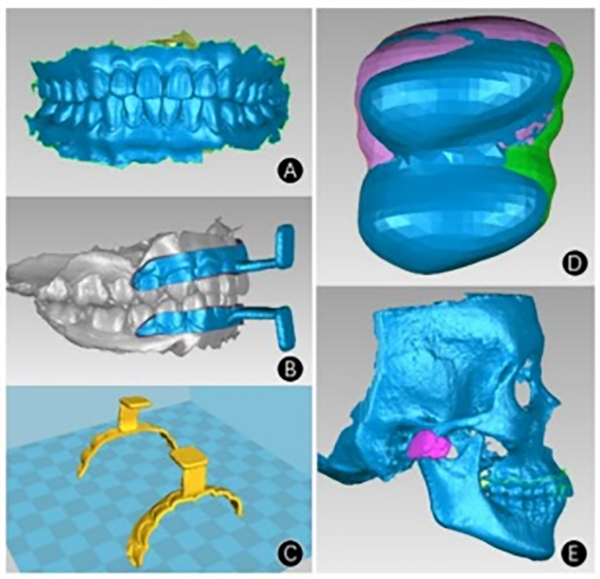
The acquisition process of the envelope Surface of Condyle Movement
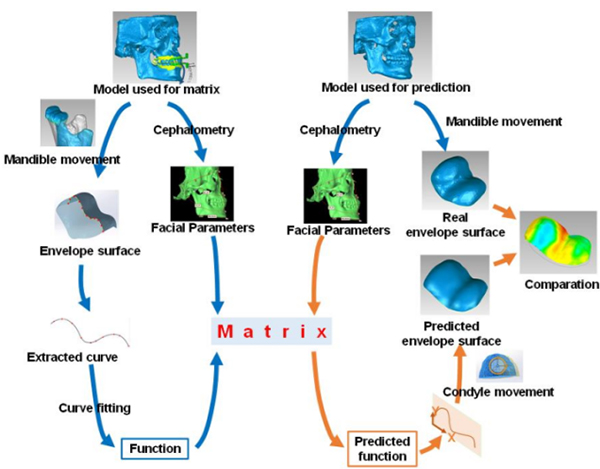
Prediction of condylar movement envelope surface based on facial morphology
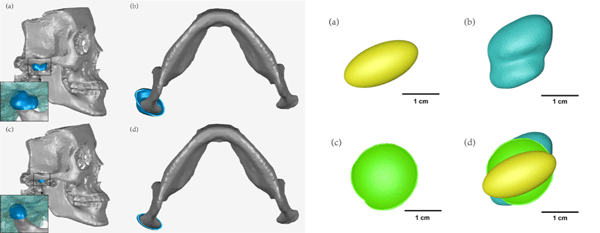
Geometry of different fossa prostheses.
(A) Ellipsoidal fossa prosthesis. (B) Envelope-based fossa prothesis. (C) Biomet fossa prosthesis. (D)Comparison of the range of condylar motion.
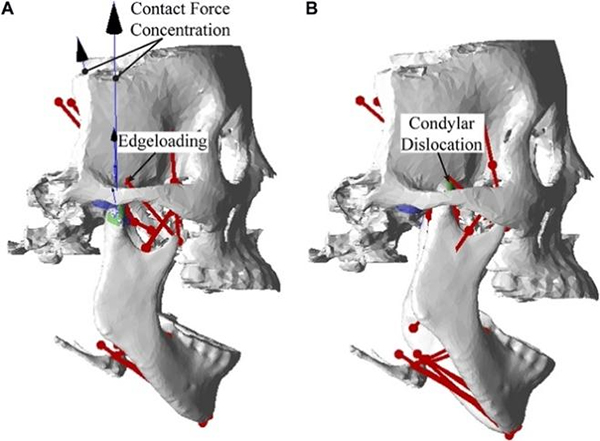
Modeling of Oral Maxillofacial Musculoskeletal System
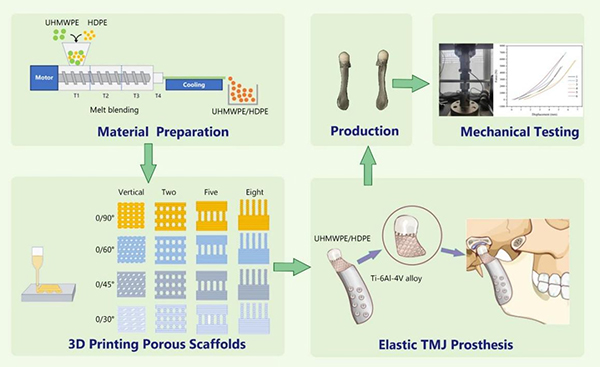
Design, fabrication, and evaluation of a novel 3D-printed temporomandibular joint prosthesis enhanced with elastic layers
Research on the applications and mechanisms of biodegradable magnesium-based alloys for maxillofacial defect reconstruction
We have successfully developed an oral biodegradable magnesium metal guided bone regeneration membrane with a purity of 6N grade, forming a new type of implant restoration material system.The ultra-pure magnesium membrane is 2 - 3 orders of magnitude higher than the pure magnesium material (purity 99.95%) used in the Navamag membrane (Biotiss, Germany), which is the only one that obtained CE certification in 2021 in the international market, representing the next-generation pure magnesium material. We participated in formulating the relevant national medical industry standards and group standards for the quality evaluation of oral magnesium membrane products and formulated the product technical requirements for magnesium alloy guided tissue regeneration membranes.
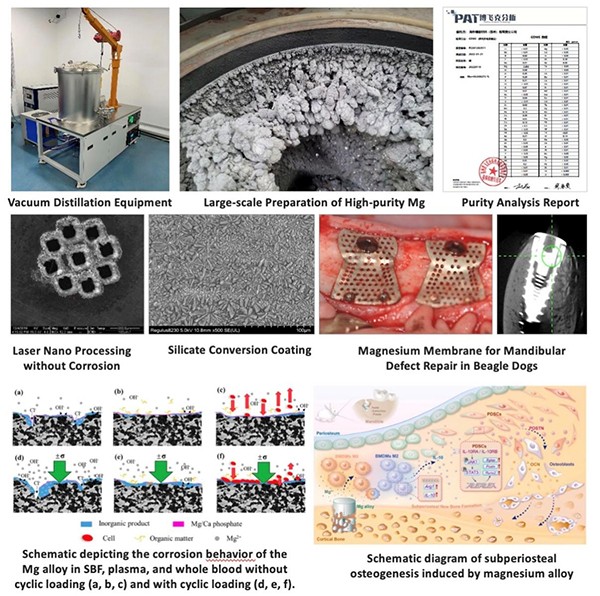
RECENT PUBLICATIONS
Bioinspired Cell-Membrane-Like Hybrid Coating for Enhanced Bioactivity and Corrosion Resistance of Magnesium-Based Implants
Rare Metals, February 2025
Design, fabrication and evaluation of a novel 3D-printed temporomandibular joint prosthesis enhanced with elastic layers
International Journal of Bioprinting, January 2025
A biodegradable magnesium alloy promotes subperiosteal osteogenesis via interleukin-10-dependent macrophage immunomodulation
Biomaterials, December 2024
Bifidobacterium breve derived indole-3-lactic acid ameliorates colitis-associated tumorigenesis by directing the differentiation of immature colonic macrophages
Theranostics,2024
Prediction of jaw opening function after mandibular reconstruction using subject-specific musculoskeletal modelling
Journal of oral rehabilitation, June 2024
Duplex Fluorinated and Atomic Layer Deposition-Derived ZrO2 Coatings Improve the Corrosion Resistance and Mechanical Properties of Mg-2Zn-0.46Y-0.5Nd (wt.%) Alloy Plates and Screws
Materials, July 2024
Prediction of condylar movement envelope surface based on facial morphology
Heliyon, July 2023
Oral administration of Bifidobacterium breve improves anti-angiogenic drugs-derived oral mucosal wound healing impairment via upregulation of interleukin-10
International Journal of Oral Science, 2023
Long-Term Temporospatial Complementary Relationship between Degradation and Bone Regeneration of Mg–Al Alloy
ACS Applied Bio Materials, September 2023
Designing customized temporomandibular fossa prosthesis based on envelope surface of condyle movement: validation via in silico musculoskeletal simulation
Frontiers in Bioengineering and Biotechnology, October2023
Effects of inorganic ions, organic particles, blood cells, and cyclic loading on in vitro corrosion of Mg–Al alloys
Journal of Magnesium and Alloys, July 2023
Three-dimensional radiological anatomy of condyle trabecular bone based on a Volume-of- Interest analysis
Dentomaxillofacial Radiology, June 2022
Comparative study of temporomandibular articular fossa bone surface and the envelope surface of the condyle movement
Chinese Journal of Dental Research,2022
Study on the reconstruction of a four-dimensional movement model and the envelope surface of the condyle in normal adults
British Journal of Oral and Maxillofacial Surgery, September 2021
Accuracy of (18) F-FDG PET/CT in Detection of Neck Metastases of Oral Squamous Cell Carcinoma in Patients Without Large Palpable Lymph Nodes
Oral Surg Oral Med Oral Pathol Oral Radiol, 2020
Suppression of G6PD induces the expression and bisecting GlcNAc-branched N-glycosylation of E-Cadherin to block epithelial-mesenchymal transition and lymphatic metastasis
British Journal of Cancer, 2020
Expert consensus on procedures and operations of navigation-guided needle biopsy techniques for skull base tumors
Chin J Dent Res ,2020
Performance of Robotic Assistance for Skull Base Biopsy: A Phantom Study
J Neurol Surg B Skull Base, 2017
Prospect of robotic assistance for fully automated brachytherapy seed placement into skull base: Experimental validation in phantom and cadaver
Radiother Oncol, 2017
Bifidobacterium breve as a delivery vector of IL-24 gene therapy for head and neck squamous cell carcinoma in vivo
Gene Ther, 2017
TEAM
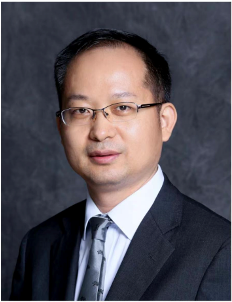
Jianmin Han, Ph.D
Professor, Chief Physician
Team member focus on biodegradable magnesium-based alloys
hanjianmin@bjmu.edu.cn
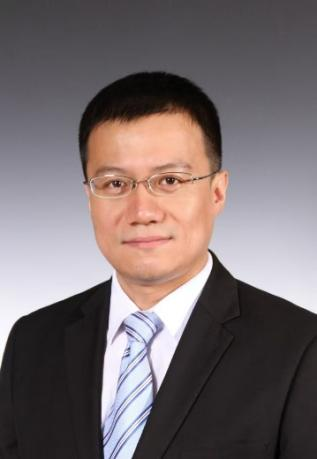
Xiangliang Xu, MD, DDS
Associate Chief Physician
Team member focus on Functional Artificial Joints
kqxxl@126.com

Yuxing Guo, MD, DDS
Chief Physician, Associate Professor
Team member focus on skull base tumor
gladiater1984@163.com

Jing Wang, MD, DDS
Associate Chief Physician
Team member focus on Musculoskeletal Dynamics
sagil123@yahoo.com.cn

Lin Wang, Ph.D.
Attending Physician, Research Assistant
Team member focus on occult cervical lymph node metastasis precision diagnosis and immune-metabolic reprogramming in tumor environment
linwang911@126.com
CONTACT
Chuanbin Guo
guodazuo@vip.sina.com
Oral and Maxillofacial Surgery,
Peking University School and Hospital of Stomatology,
No.22 Zhongguancun South Avenue,
Haidian District, Beijing 100081, PR China
last text: Yu Guangyan






